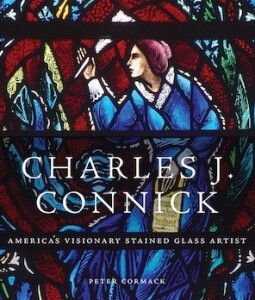
Charles J. Connick: America’s Visionary Stained Glass Artist
by Peter Cormack
Peter Cormack, Charles J. Connick: America’s Visionary Stained Glass Artist (to be published by Yale University Press, New Haven & London, summer 2024). Available from Yale University Press.
For some years, British art historian Peter Cormack has been researching the life and work of Charles J. Connick, the foremost American stained glass artist of the twentieth century. Here is a brief summary of his new book, which will be published in the USA on June 25th:
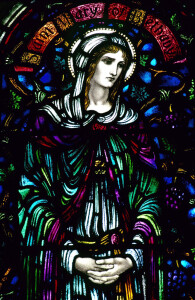
Detail of window (1915) at Congregational Church, Marion, MA
Although Charles J. Connick (1875-1945) primarily worked in stained glass, this account of his life and work is wide-ranging and focuses on him not only as artist and craftworker but also as a significant twentieth-century cultural figure in America, whose friends included the poets and writers Robert Frost, Sherwood Anderson, Joseph Auslander and John Holmes, as well as leading architects such as Ralph Adams Cram, Charles Maginnis and Harold Whitehouse. His patrons ranged from Delia McCabe, a domestic servant in New York City, to some of the most celebrated names in US business and industry (the Heinzes of Pittsburgh, the Procters of Procter & Gamble, the Crockers of San Francisco and the daughter of the founder of Pinkerton’s Detective Agency, et al.) and notable political figures, such as Boston’s notorious Mayor James Michael Curley.
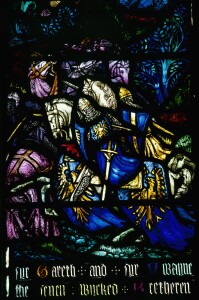
Detail of ‘Holy Grail’ window (1919) at Procter Hall, Graduate College, Princeton, NJ
In many ways Connick’s life-story is quintessentially about the ‘American Dream’. Born into poverty in rural Pennsylvania and having received very little formal education, he rose to become the undoubted leader of his art in America, with an international reputation and the award of honorary degrees from Princeton and Boston universities, as well as medals and other distinctions from international exhibitions and professional institutions.
In its examination of Connick’s career as a stained glass designer and master-craftsman, the book encompasses the profound influences of medieval art – especially the windows of the great European Cathedrals (Chartres, Paris, Rheims, Canterbury, York, etc.) – and of the British Arts & Crafts Movement, with which he had close and fruitful connections. Yet Connick was decidedly not – as he has sometimes been wrongly characterised – a ‘Gothic Revivalist’. He was committed to a modern vision of his chosen art form and, in his mature works, developed a wholly convincing idiom in design and technique that was boldly graphic and dynamic while also enriched by traditional technique and materials.
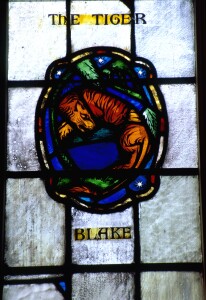
William Blake’s poem ‘Tiger’, window (1928) at Peirce Hall, Kenyon College, Gambier, OH
He was especially concerned to create windows that would resonate for his contemporaries, and introduced specifically American themes never previously represented in stained glass – notably at Heinz Memorial Chapel at the University of Pittsburgh. An avid reader of classic and modern literature, Connick loved to depict literary subjects, whether on an epic scale, as at Princeton University Chapel, or on the more intimate and domestic scale of his glazing scheme at Kenyon College in Gambier, Ohio.
Amongst the many ecclesiastical commissions that were undertaken in his studio (at 9 Harcourt Street in Boston’s Back Bay neighborhood), which was organised in accordance with Arts & Crafts precepts, are major glazing schemes for St John the Divine Cathedral and St Patrick’s Cathedral in New York and for Grace Cathedral in San Francisco. Connick himself was a charismatic communicator about the history and practice of his craft: he lectured throughout the country and his 1937 book Adventures in Light and Color, widely recognised as a classic of craft literature, was praised by Lewis Mumford, who spoke of the ‘ecstatic brilliance’ that Connick’s windows had brought to American churches.
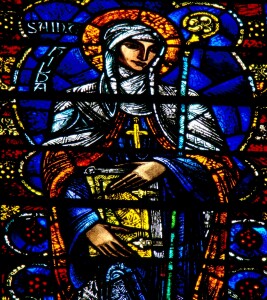
Detail of ‘St Hilda of Whitby’ (1933) window at Grace Cathedral, San Francisco, CA
Connick’s stained glass can be seen throughout the United States, in religious buildings, universities, schools and libraries, business offices and in private homes and many examples are illustrated in the book. They are, in the author’s words, ‘among the nation’s greatest cultural treasures’.
Peter Cormack MBE, FSA, HonFMGP, is the former Curator of the William Morris Gallery, London, where he researched and organised many exhibitions on William Morris and the Arts & Crafts Movement. He is a Fellow of the Society of Antiquaries, Vice-President of the British Society of Master Glass-Painters, Honorary Brother of the Art Workers Guild and Honorary Curatorial Adviser for William Morris’s country home, Kelmscott Manor in Oxfordshire. His books include Arts & Crafts Stained Glass (Yale University Press, 2015) and The Stained Glass Work of Christopher Whall (Charles J. Connick Foundation & Boston Public Library, 1999).
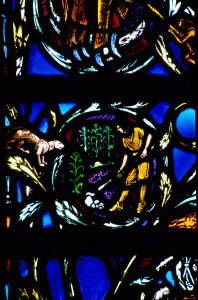
‘Pioneer Farmer and Cougar’ detail of window (1937) in Heinz Memorial Chapel, Pittsburgh, PA
This book is listed on Christies “The Best Art Books to Look Out For” in 2024.
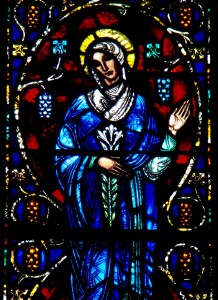
‘Virgin Mary’ detail of window (1931) at Church of the Covenant, Erie, PA
